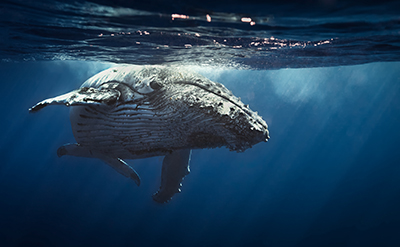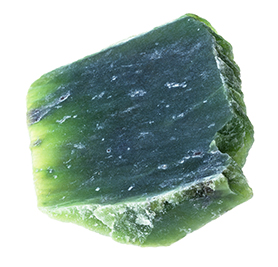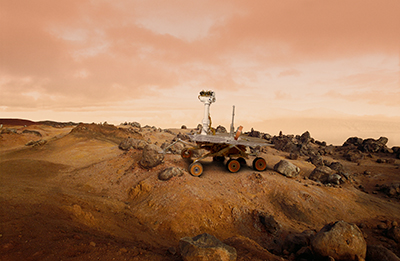In honor of our 100th anniversary, we thought it’d be fun to share some interesting facts about how our products have been used over the years. It turns out customers have used them in a lot of interesting ways—here are 10 examples.
Where’s the Beef?
Back in the 60s, one of our 2.25 MHz transducers was used to measure the thickness of meat and fat in live animals. It turns out that this actually worked — a trained operator could distinguish skin, fat, and muscle layers based on the various echoes. However, there was one problem—getting the animal to stand still. To get clean echoes and properly couple the transducer, the animal had to remain almost motionless. Whoa, Bessie! Don’t move!

Rubber, Blubber, and a Transducer
A famous oceanographic institute bought an EPOCH® flaw detector and a 500 kHz transducer as part of a study on Atlantic whales. Biologists attached the transducer to the end of a long pole, floating alongside a surfaced whale in a rubber dinghy, and pressed the transducer to the whale to measure the blubber thickness.
Okay, So It Gets Kind of Gross…
Soft tissue is generally quite transmissive to ultrasound, and we’ve sold gages for several biomedical research applications. Among the animal parts that have been measured are bovine pericardial tissue (used to make artificial heart valves for humans), canine intestines (medication study), rabbit corneas (similar to human corneas), and blood vessel thickness (bovine, but the actual application was probably in humans).
Thin Skinned?
Researchers have used our high-frequency immersion transducers to measure thin layers of human skin in studies of psoriasis and burn
healing . Sound velocity in bone samples with flat, parallel sides can also be readily measured. Our products have been used to measure eggshells and lobster shells (the latter in a growth/health study). We’ve even sold a system to a Japanese customer who used it to measure the sound velocity and attenuation of melons, which correlates to the ripeness of the fruit.
Pasta Cheese Please
A food producer purchased an EPOCH instrument to measure the velocity of sound through sealed, opaque bags filled with pasta and cheese. The producer used the EPOCH and two 500 kHz V601 transducers and a specially designed test fixture to verify that the bags were filled with the proper proportions of macaroni and cheese sauce.
Armored Candy Shells
Thickness gages have been used to measure the outer-shell thickness of hard-shell chocolate candy, presumably to ensure uniformity.
On Thin Ice?
The thickness of indoor skating rink ice can be measured with an Olympus corrosion gage. The rink’s pure ice presents a very fast and transmissive surface to the gage, and the low temperatures cause backing spikes in contact transducers, so a 2 MHz, D797 dual transducer is used. Pond ice measurements can require gain and blanking adjustments because of the presence of bubbles and cracks that reflect sound waves away from the bottom surface.

Geologically Speaking
Researchers have purchased EPOCH instruments to measure sound velocity in rocks, compacted soil, glacial ice, and other geological samples. Low-frequency testing (500 kHz and below) is done on prepared samples with flat, parallel sides. Elastic modulus can often be calculated by adding a through-transmission shear wave test to obtain the shear velocity.
Knock on…
We don’t usually go looking for wood applications since it’s a tiny and specialized niche, but as with geological samples, testing is generally possible at low frequency (50–250 kHz) in through-transmission with an EPOCH or a pulser/receiver. Rot in marine pilings and telephone poles can be identified by changes in through-transmission sound velocity. Pulse/echo testing is not possible in wood, but musical instrument makers have used Magna-Mike® gages for thickness measurement.
Space – The Final Frontier
IPLEX looks upward:
The IPLEX MX videoscope was one of the first battery-operated videoscopes, making it very advanced for its time. In 2005, an IPLEX MX was modified to mount to an astronaut’s spacesuit for use in zero gravity during extravehicular activity (EVA). A couple of years later, the more powerful IPLEX SA videoscope was modified for the same EVA purpose. Neither videoscope ever made it into outer space. More recently in 2017, the IPLEX FX was used in the refurbishing of the starship Enterprise model (the same one used in a famous 60s TV show) that’s on display at the Smithsonian National Air & Space Museum. The videoscope was critical for understanding how the model was constructed and minimizing damage during the refurbishment.
EPOCH 6LT reaches the stratosphere:
Down a dusty road in Bishop, California, in the foothills of the Sierra Nevada Mountains, the EPOCH 6LT flaw detector was attached to a high-altitude weather balloon and sent into the stratosphere. A video camera was also mounted to the balloon to capture all the action (check out the video here). We had no idea whether the flaw detector would survive the trip. In a little under two hours, the balloon reached its maximum altitude of 121,340 feet, floated around for a while, then popped. A small parachute deployed, slowing the EPOCH 6LT flaw detector’s fall until it landed deep within a rugged and remote area. Three days later, the flaw detector was recovered intact. You might say that was an “extreme” drop test!

Olympus XRD lands on Mars!
The technology that powers Olympus X-ray diffraction (XRD) instruments
was originally developed for testing Martian soil onboard the Mars Curiosity rover. XRD works by passing X-rays through a powdered soil sample to determine its mineralogy. If the minerals have a crystalline structure, the XRD analyzes their diffraction pattern. This technology helps scientists understand the minerals that are part of the Martian landscape and its geological history.
Related Content
What Goes Up, Must Come Down—the EPOCH 6LT Flaw Detector’s Wild Ride

.png?rev=3E2D)